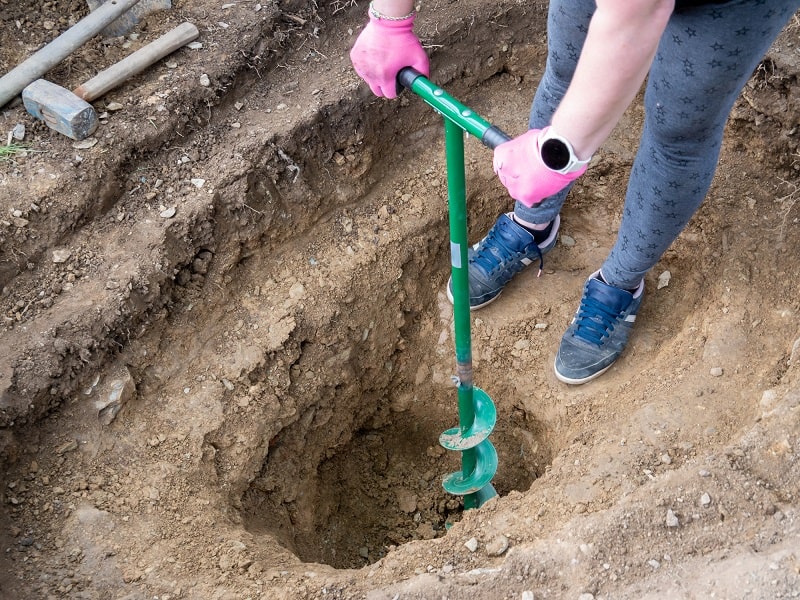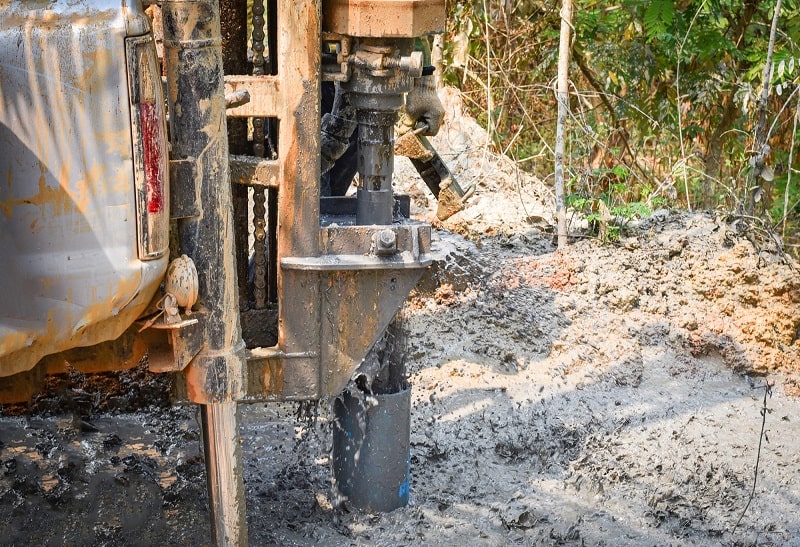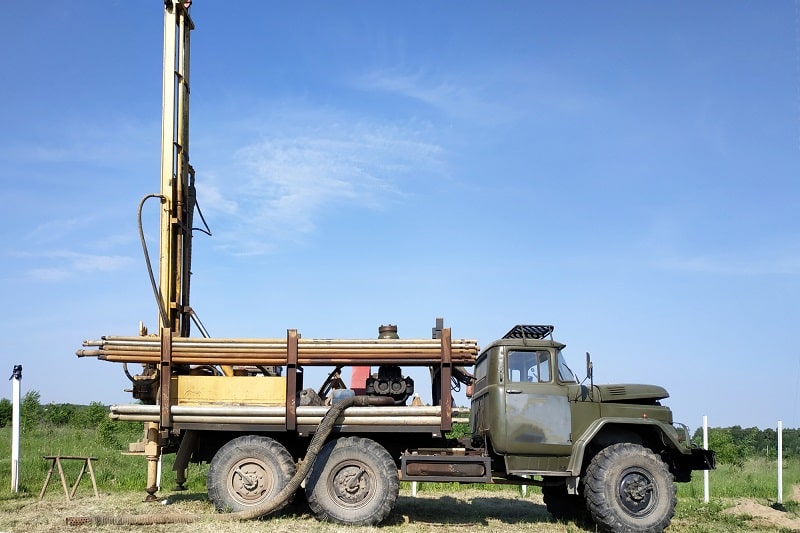Water is a precious commodity and always has been, which is why people have been using wells to access underground water for thousands of years.
Despite technological developments, there remain just three basic types of well.
#1 The Dug Well

To create this type of well, you dig until you hit water and then extract that water by hand using a bucket and pulley system.
The oldest and simplest type of well, the dug well requires little more than a couple of shovels and some serious muscle power. This type of dug well needs to be at least two feet wide to give the person digging it enough space to maneuver.
You can dig your own shallow well using a pick, shovel, and a bucket on a pulley to remove the dirt. It’ll go quicker if you’ve got some slightly more advanced tools like a post hole digger or augur.
Although digging a well isn’t rocket science, it is potentially dangerous.
Not only could the sides of the well cave in, but because dug wells tend to be quite shallow, they’re easily contaminated by surface run-off. This may contain chemicals, and other contaminants, including overflow from sewers and septic tanks.
Another downside of being shallow is that your well is more likely to dry up during arid periods or times of drought.
See these posts for further information:
#2 The Driven Well

A driven or sand-point well is constructed by driving a narrow pipe into shallow water-bearing gravel or sand. To create a driven well, a steel pipe with a diameter of 1¼ inches to 2 inches is driven into the ground. At the bottom of this pipe is a filtration screen attached to a hardened steel tip.
Once the first length of pipe, with the steel tip, is driven into the ground, additional lengths are added until the first pipe hits an aquifer.
To make the process easier, a pilot hole is sometimes dug at the surface using an augur or post-hole digger. The drive port and well screen are then driven into the ground along with the first length of pipe.
A drive cap can be used to protect the well points and drive pipe threads during the construction process. This is particularly important if you’re using a weighted driving tool or “slam hammer.”
A driven well can only be constructed in a location where the geology and groundwater supply make it feasible. That means identifying an area of sand or gravel where the water table is less than 50 feet deep.
The best way of doing this is by consulting geologic maps and surveys of your local area. You also need to establish if there is water available, which you can do by referring to the construction logs of nearby wells, or by consulting a geologist.
Water dousing or divination can also help you find the best place to sink your well.
The ideal location for a driven well is higher than the surrounding groundwater and has good drainage. This will reduce the potential for contamination.
You should also identify any possible sources of contamination, such as areas where fertilizer is used intensively or where subsurface sewage seepage systems are in place.
According to the Illinois Department of Health, a driven well should also be
“at least 10 feet from sewers, 50 feet from septic tanks, and 75 feet from sewage seepage fields.
Driven wells are usually deeper than dug wells but, if constructed by hand, are rarely deeper than 30 feet. Machine-driven wells can be deeper but rarely exceed 50 feet.
Being so shallow, driven wells are more susceptible to contamination than drilled wells, but they also have some advantages. Driven wells are comparatively cheap to construct and can also be pulled out and moved, unlike a dug or drilled well.
#3 The Drilled Well

Drilled wells or boreholes are the most common wells and the deepest. The average household drilled well is between 100 and 800 feet deep, but there are a few over 1,000.
A drilled well is constructed using a drill rig that bores into the ground 20 feet at a time. The first drill rods must pass through the “overburden” of dirt, rock, clay, and other material that sits on top of the bedrock.
Once the first 20 feet have been drilled, the next drill rod is added. This process continues until the drill hits water.
At the same time as drilling through the ground, the drill rig advances the well casing into the bored hole. This casing is usually around 6 inches wide and prevents dirt and other material from seeping into the well and contaminating the water.
As the casing is narrower than the bored hole, the space around it must be sealed using either cement or bentonite clay. Without this sealant, the water inside the well could become contaminated by water draining down from the surface around the outside of the casing.
We had a drilled well, or borehole, installed a decade ago, and it’s still going strong, producing a yield of around. 14,000 liters per hour.
The process of constructing a drilled well is expensive and nerve-wracking. I remember counting each foot, knowing that each bit of progress was costing me an arm and a leg. Imagine my relief when they found water at just over 200 feet! If it had gone much deeper, I’d have been bankrupt!
If only I’d been able to read Diane Vukovic’s article on how much it costs to dig a well before I started. I could have saved myself a fortune!
Aside from the expense of constructing a drilled well, there are a few other disadvantages. Being deeper than either the dug or driven well, a drilled well is more likely to remain productive throughout the year, regardless of rainfall. It’s also less prone to contamination, especially if it’s fitted with a watertight well cap.
That’s not to say that drilled wells never run dry or get contaminated. According to the US Environmental Protection Agency (EPA), six main contaminants affect private wells.
These include natural microorganisms washed into the well system by rainfall or snow run-off, as well as fertilizers and other chemicals from agricultural activities and fluoride which, it says, is “present in many aquifers.”
Conclusion
These are the three main types of well, although bored wells are sometimes included as a fourth. Bored wells are similar to drilled wells but are usually constructed in places where the water-bearing geologic formations are shallow and low-yielding.
A drilled well is the most expensive to install because it’s much deeper than either a driven or dug well but it’s much less susceptible to contamination.
Drilled wells also have a longer life expectancy and can produce clean water for between 30 to 50 years.
Whatever type of well you opt for, some monitoring is necessary to keep it operational. This includes regularly testing the water quality, flow rate, and static water level. Monitoring your well can prevent well failure, potentially saving you money on emergency repairs.
Also see our guide to the different types of well pump.



Hi, I’m new to all this, but one question about hand driven wells is nagging. We know that galvanized pipe should not be used or sold, as it will be poisoning us with lead. Why is there no stainless steel 1-1/4 or 2″ stainless water pipe available in a package that isn’t on an extremely expensive custom order? The well points are commonly stainless steel, after all, seems like they know to *not make this out of galvanized steel. A quick internet search says in the USA that we stopped using galvanized pipe for homes in the 80s, yet we are still using it for water usage, and according to the Wisconsin DNR, is “safe”. Who’s sleeping on the law books for this one? I’m concerned.
Any water service professional or licensed plumber can answer that for you. However some basics are in order. The Fed banned the use of lead in water lines in the 80’s but not the use of galvanized pipe. You dont want to use plain steel pipes for water due to rusting, and galv is still recommended in some applications. Galvanized deteriorates faster than other metals (copper, stainless), and also adsorbs (note spelling) lead when lead is present upstream of the galv pipe. Since many homes had already been built with galv downstream of various lead pipes, we’ve been removing lead and downstream galvanized since then. You can’t find the SS pipe you want because a) it’s very expensive b) there’s no market for it and c) there are other products that do a better job for less cost and ease of installation. 1.5 to 2 inch galv pipe is still being used in wells and is often required at certain depths due to strength. Common practise for downpipes in shallow to medium deep wells is sched 120 pvc (varies by code/region) down to a certain depth (500′ in our state). Depending on what you’re trying to do, galv pvc cpvc or black poly may be appropriate. BTW well points are made out of SS because SS is a very strong material, much stronger than galv, and is needed when driving it into the ground/rocks.